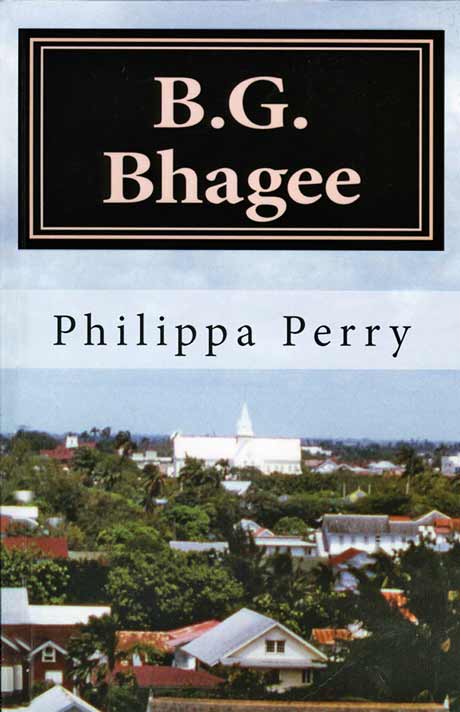Book Review
a family member
ISBN-10: 1461192196

A review by Frank Birbalsingh
Philippa Perry's B.G.Bhagee: Memories of a Colonial Childhood consists of thirty-eight sketches, each about four to six pages in length, recalling episodes in the life of the author-narrator Philippa (née Carrington) who was born in 1945 and grew up in Georgetown, Guyana. Although some episodes are directly linked to Philippa's experience as a student, they also focus on activities of people within and around her community as a whole. The appearance of another title - "B.G. Days"- on every other page of the book again emphasises an interest in presenting a general picture of life (Days) in the colony of British Guiana in the 1950s and 60s.
The volume is divided into four sections the first of which – "Lot 10"- takes its name from the author's address at Lot 10, First Street, in Georgetown, Guyana's capital city. "Lot 10" consists of twelve sketches describing Philippa's family and neighbourhood: she is one of seven children and her family owned a property with their own home on it, together with other buildings in which: "an assortment of tenants and poor relations jostled each other to survive." Philippa's portrait of her yard is compelling in true-to-life detail: "Nothing was hidden, you could see people at their open doors and windows...all around you the chattering, arguing, singing, laughing and warring, with the radio on its single station blaring forth accompaniment." Nor are animals left out of this medley of madness: "When the humans paused for breath, there were sounds of animals: the squawking of chickens that every family prized, and the yelping of dogs that belonged to no one in particular."
Mercifully, no physical violence is reported; life in the yard may be chaotic but it seems harmless, at least outwardly. Yet darker motives lurk under the surface of chaos, for example: "the seething resentment that my mother harbored, set amongst her husband's relatives...The grudges that other tenants held" or their hatred: "because we were the grandchildren of the owners and did not have to pay rent." One cannot imagine an atmosphere more fraught with suspicion, rivalry and danger, nor a more magnificent evocation of it: "they [neighbours] waited for us to stumble and fall. Goodwill was scarce; they waited for tragedy to strike." Such succinctness!
But as Philippa's unsparing eye observes, her own immediate family members are not exempt from malice. Her Aunt Cil's hopes of marriage, for instance, are thwarted by Aunt Irene who intercepts and confiscates letters sent by Aunt Cil's Guyanese boyfriend in the US, all because she [Irene] wants to keep Aunt Cil at home as her baby-sitter. Incidents like this no doubt move Philippa to write: "Our family history had its share of cruel stepmothers, children starved and beaten, wicked wiles to keep lovers apart, and poisonings and suicides with household fluids." If this sounds almost like a history of Guyana's Borgias, it also illustrates one of the best aspects of Philippa's narrative which tells the truth despite a dilemma mentioned in her "Author's Note:" "all the events [in B.G.Bhagee] happened, they are true...Some names were changed to protect me from the wrath of my relatives."
Section Two of B.G. Bhagee has special resonance since it considers the author's experience as a student, first at primary school – St Ambrose Anglican School. St. Ambrose claims special status as: "the elite of primary school(s)." It was founded in 1855 and Miss Friday who was trained in England: "was the first local woman to become its headmistress." Philippa proves to be a star student at St. Ambrose and not only wins a scholarship to Bishops, the leading girls' Government secondary school, but tops the exam list by earning the highest marks of all students in the country.
Section Two also covers Philippa's time at Bishops from 1956 to 1963. Since she regards Bishops' teachers as: "the academic elite who radiated confidence and demanded excellence," she feels they would prepare her for the real world: "By their [her teachers'] example we learned to appreciate the subtlety of insult and the power of the withering glance, a new world opened for us and Bishops armed us with weapons to survive in it." But before she can take her Advanced Level exam she is awarded a scholarship to Connecticut College in the US. It seems the scholarship was an American initiative to counterbalance scholarships then being given by East Germany and the USSR to members of the Peoples Progressive Party which was regarded as communist. This turns Guyanese into mere pawns in the Cold War tussle between the US and the USSR.
The final two sections of B.G.Bhagee "Kith and Kin" and "Afterwards" enlarge the scope of the volume's social context with fourteen additional sketches about relatives, friends and more political issues after Guyana becomes a republic in 1970 and: "turned the country into a nation of beggars , everybody waiting for handouts, old clothes, food from overseas." All this tends to confirm B.G. Bhagee as memoir rather than autobiography or fiction. But these literary categories inevitably overlap and cooperate in B.G. Bhagee to produce a portrait of the author's family and community that is simply enchanting partly because it is unsparingly truthful down to the last detail, and partly because of the author's spare and thoughtful writing. Hers is an African-Guyanese community in Georgetown, Philippa's great-grandfather having previously settled in Guyana from Barbados, and her father now working as a carpenter and cabinet maker, and later a security guard. Philippa's Georgetownian point of view comes out when she visits Essequibo and states: "Essequibo seemed at the end of civilization." The dominance of Georgetown was indisputable in colonial Guyana, and takes nothing away from an increasingly popular genre of Guyanese writing that is now coming out from Philippa Perry as well as other authors such as Godfrey Chin, Brenda DoHarris and Mona Williams.